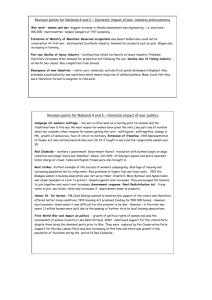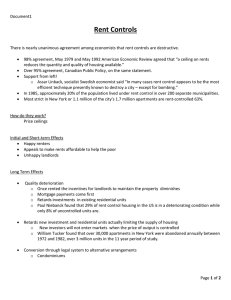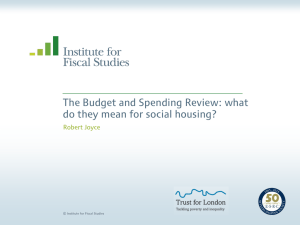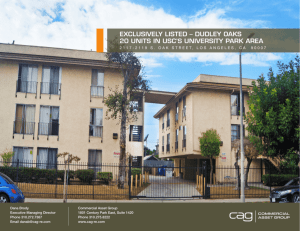The impacts of changes to social rents policy Robert Joyce
advertisement
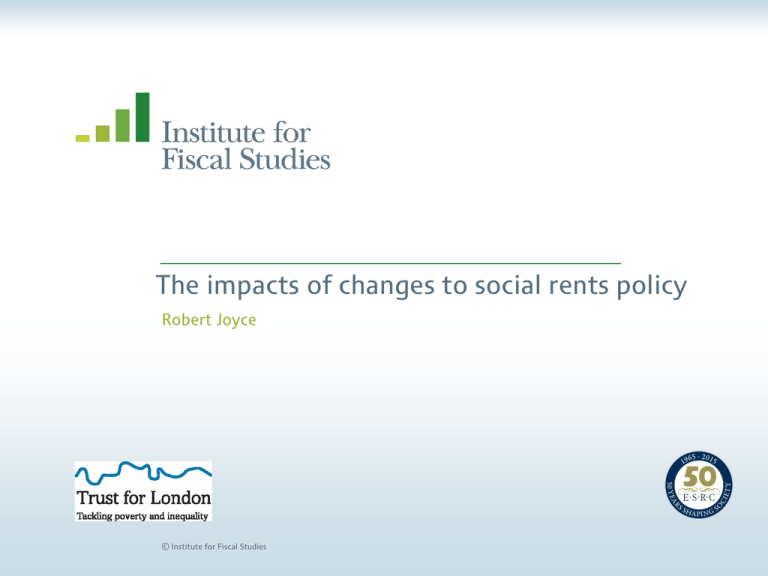
The impacts of changes to social rents policy Robert Joyce © Institute for Fiscal Studies Introduction • Draws on IFS report published on 5th November – ‘Social Rent Policy: Choices and Trade-Offs’ – www.ifs.org.uk/uploads/publications/comms/R108.pdf • We analyse effects of big changes to social rent policy in England – 1% annual cuts in social rents for next four years – ‘Pay to Stay’: market or near market rents for higher-income tenants – ‘Affordable Rents’ (i.e. higher rents) for new tenancies • With detailed modelling and quantification of impacts on – Incomes, net of rent, for tenants – Work incentives for tenants – Revenue for social housing providers and central government © Institute for Fiscal Studies Methods: (very) brief overview • Data from Family Resources Survey – Household survey which records rents, incomes and demographics – Pool data from 2010-11 to 2013-14 inclusive – 11,000 social tenant households in England; 1,800 in London • Use IFS tax and benefit model (TAXBEN) to calculate tax liabilities, benefit entitlements and net incomes for each household – Assume full take up of benefits, but 12% of social tenants entitled to HB don’t claim • For some analysis, need estimates of market rents that could be charged on properties of social renters in survey – We draw on estimates from Wilcox (2008) © Institute for Fiscal Studies Cutting social rents by 1% per year for 4 years • July 2015 Budget announced social rents in England will be cut by 1% in cash terms for four years from 2016-17 – 12% cut relative to previous plans (CPI + 1%) • Average fall of £600 in annual rents for 3.9m households in England relative to previous plans (£770 in London) – £2.3bn fall in income for social landlords (£0.5bn in London) • Reduction in rental income could reduce new housing supply... • ...as could uncertainty caused by U-turn on previous commitment – OBR assumes 14,000 fewer social homes built by 2020 as a result © Institute for Fiscal Studies Impact on social tenants’ net-of-rent incomes • Cut in social rents largely represents a transfer from social landlords to central government, rather than to social tenants – 2/3 of social tenants have rent fully or partly covered by housing benefit (HB) – HB spending reduced by £1.7bn – Net-of-rent incomes up £700m: 1.6m gain average of £420 per year – In London: 260,000 households gain average of £580 per year • What do the gainers look like?... © Institute for Fiscal Studies Impact of 12% rent cut by income (England) £45 Change in annual net income £40 £35 £30 £25 £20 £15 £10 £5 £0 Poorest 2 © Institute for Fiscal Studies 3 4 5 6 7 8 Income decile group 9 Richest Source: Figure 4.1 of Social rent policy: choices and trade-offs All The effect of rents on work incentives, given HB A made-up example Out of work Weekly housing benefit entitlement £120 £100 £80 Weaker incentive to increase earnings £60 £40 In work £20 £0 £0 © Institute for Fiscal Studies £50 £100 £150 £200 Weekly income Note: shown for single adult with weekly rents of £100 and £60, not subject to social sector size criteria £250 £300 The impact of changing social rents A made-up example Weekly housing benefit entitlement £120 Before rent cut After rent cut £100 Out of work £80 No longer any housing benefit to lose £60 £40 In work £20 £0 £0 © Institute for Fiscal Studies £50 £100 £150 Weekly income £200 Note: shown for single adult with weekly rents of £100 and £60, not subject to social sector size criteria £250 £300 Two kinds of financial work incentive 1. The incentive to be in paid work at all – Participation tax rate (PTR): proportion of total earnings taken in tax and withdrawn in benefits 2. The incentive for those in work to increase their earnings – Effective marginal tax rate (EMTR): proportion of an extra £1 of earnings taken in tax and withdrawn benefits • In both cases, higher numbers mean weaker work incentives © Institute for Fiscal Studies 12% rent cut: impact on tenants’ work incentives • Strengthens work incentives on average – Less housing benefit to lose by moving into work or increasing earnings Change in average work incentives among social tenants: Participation tax rate Effective marginal tax rate 12% cut in rents 1p off all rates of income tax -0.9 -0.9 -0.2 -0.6 • Similar effects in London: PTR down 0.7 ppts on average, EMTR among workers down 1.1 ppts • Size of impact on work incentives varies significantly by family type © Institute for Fiscal Studies The benefit cap and social rent changes • Not everyone’s work incentives are strengthened by the rent cut – Benefit cap can reverse the usual logic • From April 2016, total benefit receipt for most non-working families limited to £23,000 in London and £20,000 elsewhere – Estimate this will reduce incomes of 30,000 social tenant households – Affects the incentives of a further 70,000 working households who would be capped if out of work • For those people, a cut in social rents can actually weaken their incentive to be in work © Institute for Fiscal Studies Changing social rents when the benefit cap binds Example where HB is effectively capped at £60 Weekly housing benefit entitlement £120 Before rent cut (without benefit cap) Before rent cut After rent cut £100 £80 People earning in this range lose MORE HB by moving into work when their rent is LOWER £60 £40 £20 £0 £0 © Institute for Fiscal Studies £50 £100 £150 Weekly income £200 Note: shown for single adult with weekly rents of £100 and £60, not subject to social sector size criteria, whose benefit income excluding HB is £60 below the cap. Assumed to earn £9 per hour. £250 £300 Pay to Stay • From 2017-18, social landlords required to charge tenants with incomes over £30,000 (£40,000 in London) market or ‘near market’ rents – LAs have to return additional income to Treasury; HAs can keep it • We expect Pay to Stay to affect 250,000 social tenant households – Highest-income 7% – 80% of whom are in the top half of the overall income distribution • Government currently consulting on precisely how social rents should increase as incomes rise beyond Pay to Stay threshold – Matters for impact on revenues, incomes and work incentives © Institute for Fiscal Studies Pay to Stay: direct rent subsidy by income £3,500 Cliff edge 50% taper 20% taper Annual direct rent subsidy £3,000 £2,500 150k people - mean EMTR 85% £2,000 300k people - mean EMTR 56% £1,500 £1,000 £500 £0 £25,000 © Institute for Fiscal Studies £30,000 £35,000 £40,000 £45,000 Annual family taxable income Source: Figure 4.3 of Social rent policy: choices and trade-offs £50,000 Universal credit and social rent changes • Universal credit is replacing 6 means-tested benefits for those of working age – Income support, income-based JSA, income-based ESA, child and working tax credits, housing benefit • Universal credit will slightly dampen the impact of changing social rents on tenants’ incomes and work incentives • More working social tenants will be entitled to universal credit (51%) than are entitled to housing benefit (36%) – More working households see a change in rent offset by benefits © Institute for Fiscal Studies Summary • 12% cut in social rents (relative to previous plans) will benefit central government more than tenants – Tenants’ work incentives will be strengthened – Incomes of social landlords cut, with potential effects on house-building • Pay to Stay will increase rents for the highest-income tenants – Makes sub-market rents slightly more like housing benefit: more targeted on lowest incomes, weaker work incentives – Precise impact depends on how rents rise once incomes increase beyond Pay to Stay threshold: an important choice • Interactions with benefit reforms are important too – Benefit cap, universal credit © Institute for Fiscal Studies Recent rent policy displays lack of consistency • Rents will fall for existing tenants, while ‘Affordable Rents’ mean higher rents for new tenancies • Rent cut announced in Budget came one year into ten-year commitment to real increases – Danger of uncertainty over future – harmful for tenants and providers © Institute for Fiscal Studies The impacts of changes to social rents policy Robert Joyce © Institute for Fiscal Studies
